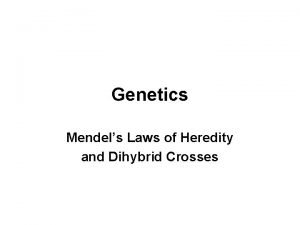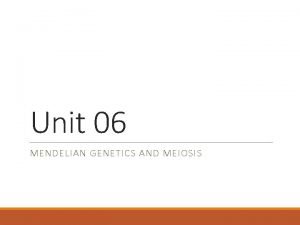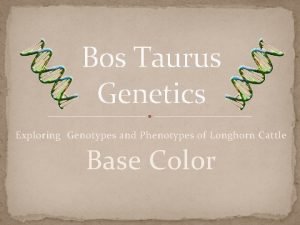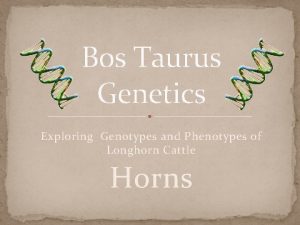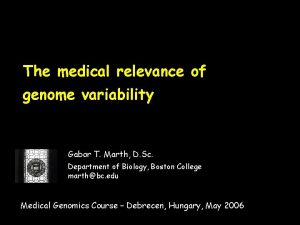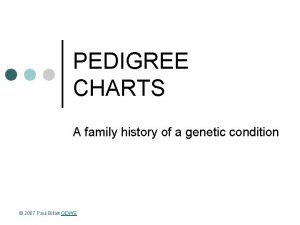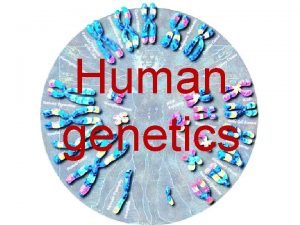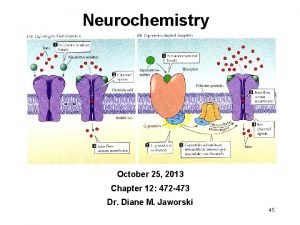1 Q PAX Ophthalmicana With respect to genetics




























































- Slides: 60

1 Q PAX Ophthalmicana ? ? ? With respect to genetics, to what does the term Central Dogma refer?

2 A PAX Ophthalmicana DNA RNA Protein With respect to genetics, to what does the term Central Dogma refer? It refers to the two steps involved in transforming genetic information into protein

3 Q PAX Ophthalmicana DNA ? RNA Protein With respect to genetics, to what does the term Central Dogma refer? It refers to the two steps involved in transforming genetic information into protein: --The first step is the transcription of DNA code into RNA code

4 A PAX Ophthalmicana DNA Transcription RNA Protein With respect to genetics, to what does the term Central Dogma refer? It refers to the two steps involved in transforming genetic information into protein: --The first step is the transcription of DNA code into RNA code

5 Q PAX Ophthalmicana DNA Transcription RNA ? Protein With respect to genetics, to what does the term Central Dogma refer? It refers to the two steps involved in transforming genetic information into protein: --The first step is the transcription of DNA code into RNA code; followed by --the translation of the RNA code into a protein

6 A PAX Ophthalmicana DNA Transcription RNA Translation Protein With respect to genetics, to what does the term Central Dogma refer? It refers to the two steps involved in transforming genetic information into protein: --The first step is the transcription of DNA code into RNA code; followed by --the translation of the RNA code into a protein

7 Q PAX Ophthalmicana DNA Transcription In this context, what is a transcription factor? RNA Translation Protein With respect to genetics, to what does the term Central Dogma refer? It refers to the two steps involved in transforming genetic information into protein: --The first step is the transcription of DNA code into RNA code; followed by --the translation of the RNA code into a protein

8 A PAX Ophthalmicana DNA Transcription In this context, what is a transcription factor? A protein that regulates the transcription process for a specific gene RNA Translation Protein With respect to genetics, to what does the term Central Dogma refer? It refers to the two steps involved in transforming genetic information into protein: --The first step is the transcription of DNA code into RNA code; followed by --the translation of the RNA code into a protein

9 Q PAX Ophthalmicana DNA Transcription In this context, what is a transcription factor? A protein that regulates the transcription process for a specific gene RNA Do transcriptions factors play an important role in the genetic process? Translation Protein With respect to genetics, to what does the term Central Dogma refer? It refers to the two steps involved in transforming genetic information into protein: --The first step is the transcription of DNA code into RNA code; followed by --the translation of the RNA code into a protein

10 A PAX Ophthalmicana DNA Transcription In this context, what is a transcription factor? A protein that regulates the transcription process for a specific gene RNA Translation Do transcriptions factors play an important role in the genetic process? Indeed they do. In fact, about 10% of all genes in humans code for transcription factors! Protein With respect to genetics, to what does the term Central Dogma refer? It refers to the two steps involved in transforming genetic information into protein: --The first step is the transcription of DNA code into RNA code; followed by --the translation of the RNA code into a protein

11 Q PAX Ophthalmicana DNA Transcription In this context, what is a transcription factor? A protein that regulates the transcription process for a specific gene RNA Do transcriptions factors anin important role Does transcription-factor dysfunction play a role ophthalmic dz? in the genetic process? Indeed theyofdo. In fact, about 10% of all Translation Indeed it does—a number important ophthalmic genes in humans code for transcription factors! conditions can be traced to transcription-factor mutations Protein With respect to genetics, to what does the term Central Dogma refer? It refers to the two steps involved in transforming genetic information into protein: --The first step is the transcription of DNA code into RNA code; followed by --the translation of the RNA code into a protein

12 A PAX Ophthalmicana DNA Transcription In this context, what is a transcription factor? A protein that regulates the transcription process for a specific gene RNA Do transcriptions factors anin important role Does transcription-factor dysfunction play a role ophthalmic dz? in the genetic process? Indeed theyofdo. In fact, about 10% of all Translation Indeed it does—a number important ophthalmic genes in humans code for transcription factors! conditions can be traced to transcription-factor mutations Protein With respect to genetics, to what does the term Central Dogma refer? It refers to the two steps involved in transforming genetic information into protein: --The first step is the transcription of DNA code into RNA code; followed by --the translation of the RNA code into a protein

13 Q PAX Ophthalmicana DNA Transcription In this context, what is a transcription factor? A protein that regulates the transcription process for a specific gene RNA Do transcriptions factors anin important role Does transcription-factor dysfunction play a role ophthalmic dz? in the genetic process? Indeed theyofdo. In fact, about 10% of all Translation Indeed it does—a number important ophthalmic genes in humans code for transcription factors! conditions can be traced to transcription-factor mutations Protein The Fundamentals book lists three transcription-factor (genes) With respect that to genetics, to what does for thethe term Centralare Dogma are especially important eye—what they? refer? It refers to the -- two steps involved in transforming genetic information into protein: --The first ste--p is the transcription of DNA code into RNA code; fo llowed by --the translation of the RNA code into a protein --

14 A PAX Ophthalmicana DNA Transcription In this context, what is a transcription factor? A protein that regulates the transcription process for a specific gene RNA Do transcriptions factors anin important role Does transcription-factor dysfunction play a role ophthalmic dz? in the genetic process? Indeed theyofdo. In fact, about 10% of all Translation Indeed it does—a number important ophthalmic genes in humans code for transcription factors! conditions can be traced to transcription-factor mutations Protein The Fundamentals book lists three transcription-factor (genes) With respect that to genetics, to what does for thethe term Centralare Dogma are especially important eye—what they? refer? It refers to the two steps involved in transforming genetic information into protein: --PAX 2 --The first ste--PAX 3 p is the transcription of DNA code into RNA code; fo llowed by --the translation of the RNA code into a protein --PAX 6

15 Q PAX Ophthalmicana In the present context, what is the origin of the word PAX? Where does it come from? The Fundamentals book lists three transcription-factor (genes) that re especially important for the eye—what are they? --PAX 2 --PAX 3 --PAX 6

16 A PAX Ophthalmicana In the present context, what is the origin of the word PAX? Where does it come from? It is a portmanteau of the term ‘PAired (homeo)bo. X’ The Fundamentals book refers to PAX genes both as ‘paired homeobox’ and ‘paired box’ genes The Fundamentals book lists three transcription-factor (genes) that re especially important for the eye—what are they? --PAX 2 --PAX 3 --PAX 6

17 Q PAX Ophthalmicana In the present context, what is the origin of the word PAX? Where does it come from? It is a portmanteau of the term ‘PAired (homeo)bo. X’ Generally speaking, what are PAX genes involved in? The Fundamentals book lists three transcription-factor (genes) that re especially important for the eye—what are they? --PAX 2 --PAX 3 --PAX 6

18 A PAX Ophthalmicana In the present context, what is the origin of the word PAX? Where does it come from? It is a portmanteau of the term ‘PAired (homeo)bo. X’ Generally speaking, what are PAX genes involved in? Morphogenesis The Fundamentals book lists three transcription-factor (genes) that re especially important for the eye—what are they? --PAX 2 --PAX 3 --PAX 6

19 Q PAX Ophthalmicana In the present context, what is the origin of the word PAX? Where does it come from? It is a portmanteau of the term ‘PAired (homeo)bo. X’ Generally speaking, what are PAX genes involved in? Morphogenesis Of these three PAX genes, which is most important to the development of the eye? The Fundamentals book lists three transcription-factor (genes) that re especially important for the eye—what are they? --PAX 2? --PAX 3? --PAX 6?

20 A PAX Ophthalmicana In the present context, what is the origin of the word PAX? Where does it come from? It is a portmanteau of the term ‘PAired (homeo)bo. X’ Generally speaking, what are PAX genes involved in? Morphogenesis Of these three PAX genes, which is most important to the development of the eye? PAX 6. The Fundamentals book refers to it as “the master switch for eye development. ” The Peds book says, “The PAX 6 gene is the master control gene for eye morphogenesis. ” The Fundamentals book lists three transcription-factor (genes) that re especially important for the eye—what are they? --PAX 2 --PAX 3 --PAX 6!

21 PAX Ophthalmicana In the present context, what is the origin of the word PAX? Where does it come from? It is a portmanteau of the term ‘PAired (homeo)bo. X’ Generally speaking, what are PAX genes involved in? Morphogenesis Of these three PAX genes, which is most important to the development of the eye? PAX 6. The Fundamentals book refers to it as “the master switch for eye development. ” The Peds book says, “The PAX 6 gene is the master control gene for eye morphogenesis. ” The Fundamentals book lists three transcription-factor (genes) that re especially important for the eye—what are they? --PAX 2 --PAX 3 Next let’s take a closer look at PAX 6 --PAX 6!

22 Q PAX Ophthalmicana There are four ocular abnormalities attributed to the PAX 6 gene. What are they? The mnemonic is…

23 A PAX Ophthalmicana There are four ocular abnormalities attributed to the PAX 6 gene. What are they? P A X 6 The mnemonic is…PAX 6

24 Q PAX Ophthalmicana There are four ocular abnormalities attributed to the PAX 6 gene. What are they? P A X 6 Start with the ‘P’ and work down

25 Q/A PAX Ophthalmicana There are four ocular abnormalities attributed to the PAX 6 gene. What are they? P eters anomaly A X 6

26 Q/A PAX Ophthalmicana There are four ocular abnormalities attributed to the PAX 6 gene. What are they? P eters anomaly A nirida X 6

27 Q/A PAX Ophthalmicana There are four ocular abnormalities attributed to the PAX 6 gene. What are they? P eters anomaly A nirida Congenital catara X 6

28 A PAX Ophthalmicana There are four ocular abnormalities attributed to the PAX 6 gene. What are they? P eters anomaly A nirida Congenital catara X foveal 6 h ypoplasia If you use your imagination, the 6 looks like a lower-case h…

29 Q PAX Ophthalmicana There are four ocular abnormalities attributed to the PAX 6 gene. What are they? P eters anomaly A nirida Congenital catara X foveal 6 h ypoplasia Endeavor to remember all of these. But if you have to pick just one to remember, make it…

30 A PAX Ophthalmicana There are four ocular abnormalities attributed to the PAX 6 gene. What are they? P eters anomaly A nirida Congenital catara X foveal 6 h ypoplasia Endeavor to remember all of these. But if you have to pick just one to remember, make it…aniridia.

31 PAX Ophthalmicana There are four ocular abnormalities attributed to the PAX 6 gene. What are they? P eters anomaly A nirida Congenital catara X foveal 6 h ypoplasia Endeavor to remember all of these. But if you have to pick just one to remember, make it…aniridia. Almost all cases of aniridia are 2 ndry to mutations involving PAX 6.

32 PAX Ophthalmicana There are four ocular abnormalities attributed to the PAX 6 gene. What are they? P eters anomaly A nirida Congenital catara X One final takeaway point h ypoplasia regarding aniridia… foveal 6 Endeavor to remember all of these. But if you have to pick just one to remember, make it…aniridia. Almost all cases of aniridia are 2 ndry to mutations involving PAX 6.

PAX Ophthalmicana l Nystgamus is commonly associated True l Aniridia is associated with limbal stem cell deficiency True l Presents unilaterally and bilaterally in roughly equal rates False; it is almost always bilateral Because all are tied. Don’t to PAX 6, The takeaway point: l The term ‘aniridia’ is think a misnomer because, in about ½ of cases, a knowas foveal hypoplasia, ofyou aniridia an iris condition! rudimentary iris rootit is present False; it’s a misnomer because a ONBCSC hypoplasia and cataracts The characterizes is a arerudimentary associated with irisaniridia. root is always present panophthalmic disorder l Aniridia is strongly associated with foveal and optic nerve hypoplasia True l Patients complain of (and infants suffer from) photophobia True One final takeaway point regarding aniridia… l Familial cases are at risk for Wilms tumor False; 1/3 of sporadic cases develop Wilms tumor as part of the WAGR complex l Aniridia is associated with glaucoma True l Aniridia is associated with early-onset cataracts True 33

Q PAX Ophthalmicana l ? Nystgamus is commonly associated True l ? deficiency True Aniridia is associated with limbal stem cell l Presents unilaterally and bilaterally in roughly equal rates False; it is almost always bilateral The takeaway point: Don’t think (Hints forthcoming) l…But The term ‘aniridia’ a misnomer because, in about ½ of cases, a you need to knowisthe of aniridia as an iris condition! three other eye findings iris rootitalso is present False; it’s a misnomer because a The rudimentary BCSC characterizes is a associated with aniridia: rudimentarydisorder iris root is always present panophthalmic l Aniridia is strongly associated with foveal and optic nerve hypoplasia True l Patients complain of (and infants suffer from) photophobia True One final takeaway point regarding aniridia… l Familial cases are at risk for Wilms tumor False; 1/3 of sporadic cases develop Wilms tumor as part of the WAGR complex l ? Aniridia is associated with glaucoma True l Aniridia is associated with early-onset cataracts True 34

Q An eye movement issue l Nystgamus is PAX Ophthalmicana commonly associated True l A corneal Aniridia is associated with limbal stem cellissue deficiency True l Presents unilaterally and bilaterally in roughly equal rates False; it is almost always bilateral The takeaway point: Don’t think (Hints forthcoming) l…But The term ‘aniridia’ a misnomer because, in about ½ of cases, a you need to knowisthe of aniridia as an iris condition! three other eye findings iris rootitalso is present False; it’s a misnomer because a The rudimentary BCSC characterizes is a associated with aniridia: rudimentarydisorder iris root is always present panophthalmic l Aniridia is strongly associated with foveal and optic nerve hypoplasia True l Patients complain of (and infants suffer from) photophobia True One final takeaway point regarding aniridia… l Familial cases are at risk for Wilms tumor False; 1/3 of sporadic cases develop Wilms tumor as part of the WAGR complex l Angle-related True Aniridia is associated with glaucoma condition l Aniridia is associated with early-onset cataracts True 35

A PAX Ophthalmicana l Nystgamus is commonly associated True l Aniridia is associated with limbal stem cell deficiency True l Presents unilaterally and bilaterally in roughly equal rates False; it is almost always bilateral The takeaway point: Don’t think l…But The term ‘aniridia’ a misnomer because, in about ½ of cases, a you need to knowisthe of aniridia as an iris condition! three other eye findings iris rootitalso is present False; it’s a misnomer because a The rudimentary BCSC characterizes is a associated with aniridia: rudimentarydisorder iris root is always present panophthalmic l Aniridia is strongly associated with foveal and optic nerve hypoplasia True l Patients complain of (and infants suffer from) photophobia True One final takeaway point regarding aniridia… l Familial cases are at risk for Wilms tumor False; 1/3 of sporadic cases develop Wilms tumor as part of the WAGR complex l Aniridia is associated with glaucoma True l Aniridia is associated with early-onset cataracts True 36

PAX Ophthalmicana l Nystgamus is commonly associated True l Aniridia is associated with limbal stem cell deficiency True l Presents unilaterally and bilaterally in roughly equal rates False; it is almost always bilateral The takeaway Don’t l The term point: ‘aniridia’ is think a misnomer because, in about ½ of cases, a of aniridia as an iris condition! iris rootit is present False; it’s a misnomer because a The rudimentary BCSC characterizes is a rudimentarydisorder iris root is always present panophthalmic l Aniridia is strongly associated with foveal and optic nerve hypoplasia True l Patients complain of (and infants suffer from) photophobia True One final takeaway point regarding aniridia… l Familial cases are at risk for Wilms tumor False; 1/3 of sporadic cases develop Wilms tumor as part of the WAGR complex l Aniridia is associated with glaucoma True l Aniridia is associated with early-onset cataracts True 37

38 PAX Ophthalmicana In the present context, what is the origin of the word PAX? Where does it come from? It is a portmanteau of the term ‘PAired (homeo)bo. X’ Generally speaking, what are PAX genes involved in? Morphogenesis Of these three PAX genes, which is most important to the development of the eye? PAX 6. The Fundamentals book refers to it as “the master switch for eye development. ” The Peds book says, “The PAX 6 gene is the master control gene for eye morphogenesis. ” The Fundamentals book lists three transcription-factor (genes) that re especially important for the eye—what are they? --PAX 2 --PAX 3 --PAX 6 Next, we’ll do PAX 3

Q PAX Ophthalmicana With what eponymous syndrome is PAX 3 associated? 39

A PAX Ophthalmicana With what eponymous syndrome is PAX 3 associated? Waardenburg Syndrome 40

Q PAX Ophthalmicana Waardenburg Syndrome What 3 ophthalmic findings are classic for Waardenburg syndrome? --Heterochromia iridis --Synophrys --Dystopia canthorum What non-ophthalmic finding is classic for Waardenburg syndrome? The presence of a white forelock (ie, an isolated streak of white hair in the forehead region) 41

A PAX Ophthalmicana Waardenburg Syndrome What 3 ophthalmic findings are classic for Waardenburg syndrome? --Heterochromia iridis --Synophrys --Dystopia canthorum What non-ophthalmic finding is classic for Waardenburg syndrome? The presence of a white forelock (ie, an isolated streak of white hair in the forehead region) 42

Congenital lid abnormalities: Matching Waardenburg syndrome: Heterochromia iridis, dystopia canthorum, and mild synophrys (What the heck is synophrys? ) 43

Q PAX Ophthalmicana Waardenburg Syndrome What 3 ophthalmic findings are classic for Waardenburg syndrome? --Heterochromia iridis --Synophrys What the heck is synophrys? The formal medical term for a unibrow --Dystopia canthorum What non-ophthalmic finding is classic for Waardenburg syndrome? The presence of a white forelock (ie, an isolated streak of white hair in the forehead region) 44

Q/A PAX Ophthalmicana Waardenburg Syndrome What 3 ophthalmic findings are classic for Waardenburg syndrome? --Heterochromia iridis --Synophrys What the heck is synophrys? The formal medical term for a unibrow --Dystopia canthorum What non-ophthalmic finding is classic for Waardenburg syndrome? The presence of a white forelock (ie, an isolated streak of white hair in the forehead region) 45

A PAX Ophthalmicana Waardenburg Syndrome What 3 ophthalmic findings are classic for Waardenburg syndrome? --Heterochromia iridis --Synophrys What the heck is synophrys? The formal medical term for a unibrow --Dystopia canthorum What non-ophthalmic finding is classic for Waardenburg syndrome? The presence of a white forelock (ie, an isolated streak of white hair in the forehead region) 46

Congenital lid abnormalities: Matching Waardenburg syndrome: Synophrys 47

Congenital lid abnormalities: Matching Waardenburg syndrome: Heterochromia iridis, dystopia canthorum, and mild synophrys (What the heck is dystopia canthorum? ) 48

Q PAX Ophthalmicana Waardenburg Syndrome What 3 ophthalmic findings are classic for Waardenburg syndrome? --Heterochromia iridis --Synophrys What the heck is dystopia canthorum? --Dystopia canthorum Lateral displacement of the canthi (ie, telecanthus) PLUS laterally displaced lacrimal puncta What non-ophthalmic finding is classic for Waardenburg syndrome? The presence of a white forelock (ie, an isolated streak of white hair in the forehead region) 49

A PAX Ophthalmicana Waardenburg Syndrome What 3 ophthalmic findings are classic for Waardenburg syndrome? --Heterochromia iridis --Synophrys What the heck is dystopia canthorum? --Dystopia canthorum Lateral displacement of the canthi (ie, telecanthus) PLUS laterally displaced lacrimal puncta What non-ophthalmic finding is classic for Waardenburg syndrome? The presence of a white forelock (ie, an isolated streak of white hair in the forehead region) 50

Q PAX Ophthalmicana Waardenburg Syndrome What 3 ophthalmic findings are classic for Waardenburg syndrome? --Heterochromia iridis --Synophrys What the heck is dystopia canthorum? --Dystopia canthorum Lateral displacement of the canthi (ie, telecanthus) PLUS laterally displaced lacrimal puncta What non-ophthalmic finding is classic for Waardenburg syndrome? The presence of a white forelock (ie, an isolated streak of white hair in How on earth are you supposed to recognize that the puncta are too lateral? foreheadvertical region) Draw the an imaginary line from the upper to the lower puncta. If this line crosses the cornea, the puncta are displaced. (Next time you examine a pt at the slit-lamp, take note of whether such a line crosses their cornea [it won’t]. ) 51

A PAX Ophthalmicana Waardenburg Syndrome What 3 ophthalmic findings are classic for Waardenburg syndrome? --Heterochromia iridis --Synophrys What the heck is dystopia canthorum? --Dystopia canthorum Lateral displacement of the canthi (ie, telecanthus) PLUS laterally displaced lacrimal puncta What non-ophthalmic finding is classic for Waardenburg syndrome? The presence of a white forelock (ie, an isolated streak of white hair in How on earth are you supposed to recognize that the puncta are too lateral? foreheadvertical region) Draw the an imaginary line from the upper to the lower puncta. If this line crosses the cornea, the puncta are displaced. (Next time you examine a pt at the slit-lamp, take note of whether such a line crosses their cornea [it won’t]. ) 52

Congenital lid abnormalities: Matching Dystopia canthorum. Note the telecanthus, and laterally displaced lacrimal puncta 53

Q PAX Ophthalmicana Waardenburg Syndrome What 3 ophthalmic findings are classic for Waardenburg syndrome? -- Heterochromia iridis --Synophrys --Dystopia canthorum What non-ophthalmic finding is classic for Waardenburg syndrome? The presence of a white forelock (ie, an isolated streak of white hair in the forehead region) 54

A Waardenburg Syndrome What 3 ophthalmic findings are classic for Waardenburg syndrome? -- Heterochromia iridis --Synophrys --Dystopia canthorum What non-ophthalmic finding is classic for Waardenburg syndrome? The presence of a white forelock (ie, an isolated streak of white hair in the forehead region) 55

Waardenburg Syndrome What 3 ophthalmic findings are classic for Waardenburg syndrome? -- Heterochromia iridis --Synophrys --Dystopia canthorum What non-ophthalmic finding is classic for Waardenburg syndrome? The presence of a white forelock (ie, an isolated streak of white hair in the forehead region) W aardenburg hite forelock 56

Congenital lid abnormalities: Matching Waardenburg syndrome: White forelock 57

Congenital lid abnormalities: Matching Note that Waardenburg syndrome has forms that do not involve heterochromia 58

59 Q PAX Ophthalmicana In the present context, what is the origin of the word PAX? Where does it come from? It is a portmanteau of the term ‘PAired (homeo)bo. X’ Generally speaking, what are PAX genes involved in? Morphogenesis Of these three PAX genes, which is most important to the development of the eye? PAX 6. The Fundamentals book refers to it as “the master switch for eye development. ” The Peds book says, “The PAX 6 gene is the master control gene for eye morphogenesis. ” The Fundamentals book lists three transcription-factor (genes) that re especially important for the eye—what are they? Last and most definitely least…PAX 2 mutations present --PAX 2 non-eye with colobomas of the optic nerve, and renal hypoplasia --PAX 3 --PAX 6

60 A PAX Ophthalmicana In the present context, what is the origin of the word PAX? Where does it come from? It is a portmanteau of the term ‘PAired (homeo)bo. X’ Generally speaking, what are PAX genes involved in? Morphogenesis Of these three PAX genes, which is most important to the development of the eye? PAX 6. The Fundamentals book refers to it as “the master switch for eye development. ” The Peds book says, “The PAX 6 gene is the master control gene for eye morphogenesis. ” The Fundamentals book lists three transcription-factor (genes) that re especially important for the eye—what are they? Last and most definitely least…PAX 2 mutations present --PAX 2 with colobomas of the optic nerve, and renal hypoplasia --PAX 3 --PAX 6
 Pax romana achievements
Pax romana achievements Pax animae
Pax animae Colonia dance
Colonia dance Pax romana
Pax romana Pax romana
Pax romana Pax natura
Pax natura Pax river flying club
Pax river flying club Declinazione cor cordis
Declinazione cor cordis Grannys wacky prizes
Grannys wacky prizes Ouderportaal pax
Ouderportaal pax Httpswww.youtube.comwatchvdqw4w9wgxcq
Httpswww.youtube.comwatchvdqw4w9wgxcq Pax romana
Pax romana Antikt plagg
Antikt plagg Pax romana brainpop worksheet answers
Pax romana brainpop worksheet answers Pax river flying club
Pax river flying club Pax germanica cartoon
Pax germanica cartoon Pax romana law
Pax romana law As a result of 207 years of pax romana, the roman empire
As a result of 207 years of pax romana, the roman empire The wild robot lexile
The wild robot lexile Economic impact of the pax romana
Economic impact of the pax romana Ro i rom pax
Ro i rom pax Pax romana importance
Pax romana importance Pax river flying club
Pax river flying club Paxpat.lms
Paxpat.lms Pax van tibi geli mar sta ce e meus traduzione
Pax van tibi geli mar sta ce e meus traduzione Hašiš droga
Hašiš droga Red lion pax programming
Red lion pax programming Roman empire
Roman empire Roman numeraos
Roman numeraos Rednwings
Rednwings Father of genetics
Father of genetics Genetics
Genetics Chapter 10 section 3 gene linkage and polyploidy
Chapter 10 section 3 gene linkage and polyploidy Parkinson's disease genetics
Parkinson's disease genetics Learn.genetics.utah/content/addiction/mouse
Learn.genetics.utah/content/addiction/mouse Exceptions to mendelian genetics
Exceptions to mendelian genetics Spongebob's aunt and uncle sponge wilma and sponge wilbur
Spongebob's aunt and uncle sponge wilma and sponge wilbur Population genetics
Population genetics Mendel genetics
Mendel genetics Taurus genetics
Taurus genetics Taurus genetics
Taurus genetics Harry potter genetics incomplete dominance answer key
Harry potter genetics incomplete dominance answer key Genetics
Genetics Genetics
Genetics Foil genetics
Foil genetics Forked line method genetics
Forked line method genetics Mendel's experimental design
Mendel's experimental design Nature genetics
Nature genetics Genetics vocabulary review answer key
Genetics vocabulary review answer key Chapter 12 section 1 dna the genetic material
Chapter 12 section 1 dna the genetic material Polymorphism in c
Polymorphism in c Nature review genetics
Nature review genetics Allele
Allele Chapter 10 sexual reproduction and genetics
Chapter 10 sexual reproduction and genetics Nature genetics
Nature genetics Hair color genetics
Hair color genetics Pedigree key
Pedigree key Sponge billy bob
Sponge billy bob Scope of genetics
Scope of genetics Genetics
Genetics Http://learn.genetics.utah.edu/content/addiction/
Http://learn.genetics.utah.edu/content/addiction/





























